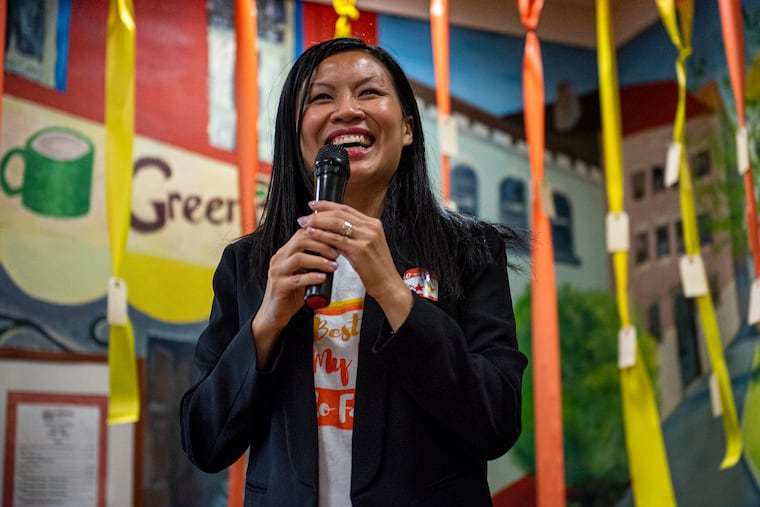The Best Day of My Life So Far lets stories bring generations together
The organization celebrated its 10th anniversary.

Homesick in her new place in Philadelphia, 25-year-old Benita Cooper did something she had never done before. On a lark, she called her grandmother in Seattle expecting a three-minute conversation. Instead, they had a long, sad talk about the grandmother’s childhood in Hong Kong. Cooper learned her grandmother had been taken from her birth parents.
The call changed her life and, later, many others. Cooper had been introduced to the power of stories and she wanted to share this new knowledge.
“She and I got closer with one story than we had ever been before,” Cooper told a small crowd in the Philadelphia Senior Center cafeteria earlier this month.
Before they hung up that day, Cooper asked her grandmother, who died last year, if she could call again and hear more stories. Her grandmother “laughed the happiest laugh I had ever heard.”
» READ MORE: How resilient seniors cope with loss
A decade ago, Cooper, now 39, asked if she could meet with patrons of the senior center and listen to their stories, some of which she retold in a blog. The storytelling gathering was so popular that Cooper, an architect with her own business, started The Best Day of My Life So Far, an organization that fosters intergenerational connection through stories.
It celebrated its 10th anniversary Nov. 8 with a storytelling party at the senior center. There were two-page handwritten stories by participants hanging from streamers across the ceiling and shorter stories composed by college students who took part in the program tied to ribbons hung on a wall. Over the course of the day, participants would add tiny stories, written on paper about the size of a luggage label, to the ribbons. As Cooper put it, “the people’s voices become the decorations.”
The stories didn’t have to be happy. Cooper’s story said the best thing is “the moment you feel a human connection.” That connection, she said, is a way to combat isolation in elders.
Most of the participants at the storytelling party were retirement age but there was a smattering of younger volunteers. They were instructed to tell each other stories about their lives and write them down. There was a 45-minute time limit, which proved surprisingly important. Once people got started talking, it was hard to get them to stop.
At one table, Sharon Browning, 68, asked for Roberta Darlene Knox’s story while Donald Marshall, 80, listened. He wasn’t planning to tell a story. Knox, 66, had proudly worked in nursing homes for decades. She had always known, she said, that she wanted to help people. Her face lit up as she talked about her former patients, and Browning listened delightedly. “I just like what I’m doing," Knox said, still speaking in present tense though she retired in 2015. “I crack jokes. I bring music into the rooms. I raise their spirits. It makes me happy.”
Eventually, Browning learned that Knox and Marshall were an item, and Knox now happily takes care of him.
Cooper warned that the time was almost up and Browning, who hadn’t said much about herself, started writing Knox and Marshall’s story, focusing on key words. “Lifelong passionate worker on behalf of elders meets senior gentleman,” she wrote. With a laugh, she looked at Donald. “Shall we say, ‘Sparks fly’?” "
“You composed it beautifully,” he said. She asked if the relationship is working. “Yes, we’re very successful," he said. “Plenty of love, day and night.” They all laughed, the kind of laughs that lighten a whole day. “Awesome! Awesome!” Browning said. “Now we all have to sign it.”
Browning, who works in another program called Just Listening that involves gathering stories, didn’t mind that there wasn’t much time for her own story. She told Knox and Marshall that their later-life love inspired her. “I’ve been by myself for a long time,” she said. “My husband died 20 years ago.”
At a nearby table, Ruth Chapman, 67 and Betty Alridge, 74, quickly found enough common ground through their stories. “She has an amazing story about how she has poured love into young people who have basically been underserved and unrepresented,” Chapman said of Alridge. “We’re on the same page as far as understanding ... we don’t need so many prisons," Alridge said. "We need more schools. We need organizations to help the family.”
Chapman, a former teacher and counselor who now is a motivational speaker, said she thinks the storytelling exercise is valuable. “I see people in my age group who basically have started shrinking away and they need to know that they are valued, and both Betty and I have seen how they aren’t and how human interaction and communication brings people out of their shell.”
Among the volunteers there that day were Keli Fazio, a professor in the communications and public health departments at The College of New Jersey, and some of her students. She sees the Best Day program as a way to help young people who might be more comfortable texting appreciate the extra layers of connection that come with face-to-face talks.
Hayley Martin, 20, a junior communications major, said her experience with Best Day changed the way she talked with her grandmother, who is 93. They talk every day and were always close, but Martin realized that most of their conversations revolved around what she was doing. Martin now says, “Tell me about your life.” She knows she’ll cherish the stories later.
“I feel like we were always close,” she said, “but now I feel like I know her on a personal level.”